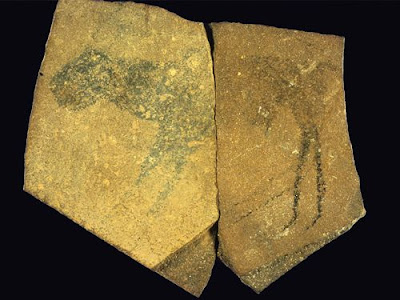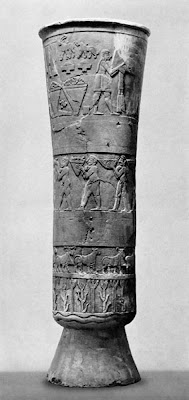Prehistoric Rock Art in Africa: the Apollo 11 Cave painted slabs (Namibia)

Painted Slab, Apollo 11 Cave, Namibia, approx. 5"x4¼".
2600 to 2800 BCE
image source: http://www.heinrich-barth-stiftung.de/index.html
 Apollo 11 excavation site
Apollo 11 excavation site
"The seven slabs of rock with traces of animal figures that were found in the Apollo 11 Cave in the Huns Mountains of southwestern Namibia have been dated with unusual precision for ancient rock art. Originally brought to the site from elsewhere, the stones were painted in charcoal, ocher, and white. Until recently, the Apollo 11 stones were the oldest known artwork of any kind from the African continent. More recent discoveries of incised ocher date back almost as far as 100,000 B.C., making Africa home to the oldest images in the world."
from: Apollo 11 (ca. 25,500–23,500 b.c.) and Wonderwerk (ca. 8000 b.c.) Cave Stones, Metropolitan Museum website http://www.metmuseum.org/toah/hd/apol/hd_apol.htm
On art and "conceptual realism"
The characteristic profile view of an animal (here a quadruped of uncertain species) is the equivalent of a "pictorial definition", providing the most complete information for prompt identification of the depicted being. In the image above it is displayed one of the oldest known examples of an approach to form and to representation that stresses the idea of the structural unity of the thing depicted, rather than a momentary, subjective, and therefore relative and dynamic view of an object or phenomenon.
The notion of structural unity will allow, or rather, demand that the most characteristic elements be displayed in the representation: therefore frontal and lateral views will be combined into one characteristic form. This sort of “conceptual” approach to form, that is, embodying our knowledge of what is represented, rather than the actual optical experience, will have a long history, marking artistic representation in prehistoric times as well as in the arts of the early civilizations and beyond.
Also designated as “law of frontality” or “conceptual realism”, this approach is linked by some authors to the very nature of the image in archaic mentality: the image is not pure “representation”, an abstract, purely mental or symbolic equivalent, but a double of the object, a real duplication of the real object. Reality itself is multidimensional, formed by layers that confront each other and interact in complex ways, as the image interacts with its object. The power of the image, therefore, in the depiction of an animated reality, is a living power. Accordingly, the “law of frontality” will be applied strictly and systematically in the depiction of human beings in ancient Mesopotamia and Egypt.
Marcelo G. Lima
reference:
Huyghe, Rene - Art forms and societies (in Chapter 3 - Agrarian Empires)
Larousse Encyclopedia of Prehistoric and Ancient Art, London: 1967
The notion of structural unity will allow, or rather, demand that the most characteristic elements be displayed in the representation: therefore frontal and lateral views will be combined into one characteristic form. This sort of “conceptual” approach to form, that is, embodying our knowledge of what is represented, rather than the actual optical experience, will have a long history, marking artistic representation in prehistoric times as well as in the arts of the early civilizations and beyond.
Also designated as “law of frontality” or “conceptual realism”, this approach is linked by some authors to the very nature of the image in archaic mentality: the image is not pure “representation”, an abstract, purely mental or symbolic equivalent, but a double of the object, a real duplication of the real object. Reality itself is multidimensional, formed by layers that confront each other and interact in complex ways, as the image interacts with its object. The power of the image, therefore, in the depiction of an animated reality, is a living power. Accordingly, the “law of frontality” will be applied strictly and systematically in the depiction of human beings in ancient Mesopotamia and Egypt.
Marcelo G. Lima
reference:
Huyghe, Rene - Art forms and societies (in Chapter 3 - Agrarian Empires)
Larousse Encyclopedia of Prehistoric and Ancient Art, London: 1967
 Apollo 11 excavation site
Apollo 11 excavation siteimage source: http://www.heinrich-barth-stiftung.de/hb_files_e/hb_projekte31.html#
 Location of Apollo 11 Cave - Namibia
Location of Apollo 11 Cave - Namibia
image source: http://www.metmuseum.org/toah/hd/apol/hd_apol.htm
 Location of Apollo 11 Cave - Namibia
Location of Apollo 11 Cave - Namibiaimage source: http://www.metmuseum.org/toah/hd/apol/hd_apol.htm


Comments